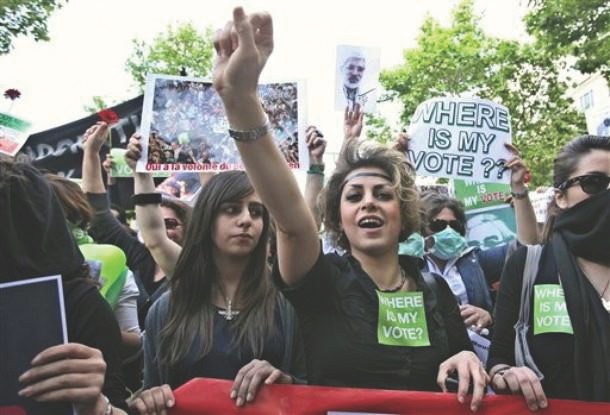
The big news last week was the Iranian drone that entered Israeli air space and triggered a potential war between Iran and Israel. Israel shot down the drone and attacked Syria. Missiles were launched. An Israeli jet was shot down. Israel retaliated. A phone call from Putin to Bibi prevented an escalation. You can read all about it in our cover story by Shmuel Rosner.
But it’s not Iranian missiles or drones I want to talk about — those get enough media attention. What I want to talk about is Iranian women.
While the Iranian terror regime has been wreaking havoc throughout the Middle East, Iranian women have quietly suffered their own form of terror.
This oppression is not new. Two years ago, while the Persian mullahs were wooing the West for its nuclear deal, I wrote about Atena Farghadani, a 28-year-old Iranian artist who was sentenced to 12 years in an Iranian prison because she “insulted” members of Parliament with her art.
Last year, according to Human Rights Watch, Narges Mohammadi, a prominent human rights defender, began serving a sentence of 10 years in prison on charges including “membership in the banned campaign of Step by Step to Stop the Death Penalty.”
While the Iranian terror regime has been wreaking havoc throughout the Middle East, Iranian women have quietly suffered their own form of terror.
And just last week, according to the Center for Human Rights in Iran (CHRI), Iranian-American art dealer Karan Vafadari and his Iranian wife, Afarin Neyssari, were sentenced to prison for being Zoroastrians, members of a pre-Islamic ancient religion. Vafadari was given a 27-year prison sentence and will receive 124 lashes. Neyssari was given 16 years.
These are hardly random events.
Remember the woman who was all over social media recently because she decided to take off her hijab during the demonstrations? Her name is Narges Hosseini, and she’s now sitting in jail, facing charges punishable by up to 10 years, including “encouraging immorality or prostitution.”
In case you haven’t heard, it is a criminal offense in Iran for women not to cover their hair and bodies in public.
Hosseini is valiantly trying to fight back, but it’s not easy when you’re up against an entrenched patriarchy that treats women like second-class objects.
For now, all Hosseini can do from her jail cell is refuse to say she’s sorry. That’s all she’s got left to maintain her dignity — a refusal to kowtow to her oppressors.
We fool ourselves when we see these cool images of “women of the revolution” and think it makes a difference. The images we saw last month of Hosseini and others were just that — images that came and went. After the cameras leave, it is the jail cells that matter. In Iran, that is where “women of revolution” end up.
And if you believe the latest Human Rights Watch report from 2017, there is little likelihood of change.
All of this makes a mockery of the hopes and dreams of many supporters of the Iran nuclear deal that the $150 billion in sanctions relief and the welcoming of Iran into the family of nations would somehow “moderate” an evil and theocratic regime. It didn’t. It made it worse.
As a famous man once said: “You can judge a nation, and how successful it will be, based on how it treats its women and its girls.” That man was President Barack Obama in 2014, a year before he concluded a deal that empowered one of the worse oppressors of women.
When Obama made that statement, I’m sure he meant “successful” in a Western, democratic kind of way. But the definition of success varies by region and ideology. For the Persian regime, for whom success means dominating the region and cementing its theocratic power, oppressing women fits right in with its mission.
#MeToo also applies to women of the Third World who are jailed and stoned to death under brutal regimes. Let’s see a march devoted mostly to those women. And let’s see Obama lead that march.
So, if Obama is looking for a new cause to take advantage of his charisma and global notoriety, I can’t think of a better one than fighting for the oppressed women of the world, starting with Iran.
I know that in Donald Trump’s America, “women’s marches” are now all the rage. And I know that when I challenge my friends who march to stand up for the rights of Iranian women in jail who can’t march for themselves, they always tell me: “Yes, yes, we’re also marching for them!”
But here’s the problem — that’s not what comes across. As Time magazine reported, “The 2017 rally in Washington, D.C., and hundreds of similar marches created solidarity for those denouncing Trump’s views on abortion, immigration, LGBT rights and more.” And this year, the #MeToo movement gave the 2018 marches a new and justified injection of outrage.
But #MeToo also applies to women of the Third World who are jailed and stoned to death under brutal regimes. Let’s see a march devoted mostly to those women. And let’s see Obama lead that march.























 More news and opinions than at a Shabbat dinner, right in your inbox.
More news and opinions than at a Shabbat dinner, right in your inbox.